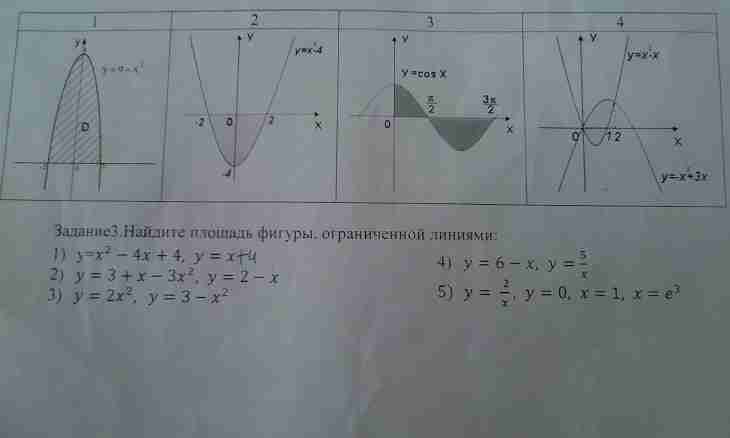The geometrical meaning of a certain integral – the area of a curvilinear trapezoid. To find the area of the figure limited to lines one of properties of integral which consists in additivity of the areas integrated on the same piece of functions is applied.
Instruction
1. By determination of integral, it it is equalis areas of the curvilinear trapezoid limited to the schedule of the set function. When it is required to find the area of the figure limited to lines it is about the curves set on graphics by two f1 (x) and f2 (x) functions.
2. Let on some interval [a, b] be set two functions which are defined and continuous. And one of functions to graphics is located above another. Thus, the visual figure limited to lines of functions and straight lines x = a, x = b is formed.
3. Then the area of a figure can be expressed the formula integrating the difference of functions on an interval [a, b]. Calculation of integral is made under the law of Newton-Leibniz according to which the result is equal to the difference of primitive function from boundary values of an interval.
4. Primer1. To find the area of the figure limited to y straight lines =-1/3·x – ½, x = 1, x = 4 and a parabola of y = - x² + 6·x – 5.
5. Decision. Construct schedules of all lines. You can see that the line of a parabola is above direct y =-1/3·x – ½. Therefore, under a sign of integration in this case there has to be a difference between the equation of a parabola and the set straight line. The integration interval, respectively, is between points x = 1 and x = 4: S = ∫ (-x² + 6·x – 5 – (-1/3·x – 1/2)) dx = (-x² +19/3·x – 9/2) dx on a piece [1, 4].
6. Find an antiderivative for the received subintegral expression: F (-x² + 19/3x – 9/2) = - 1/3x³ + 19/6x² – 9/2x.
7. Substitute values of the ends of a piece: S = (-1/3·4³ + 19/6·4² – 9/2·4) – (-1/3·1³ + 19/6·1² – 9/2·1) = 13.
8. Primer2. Calculate the area of the figure limited to lines y = √ (x + 2), y = x and a straight line x = 7.
9. Decision. This task is more difficult in comparison with previous as in it there is no second straight line, parallel abscissa axis. It means that the second boundary value of integral vaguely. Therefore, it needs to be found from the schedule. Build the set lines.
10. You will see, y straight line = x passes diagonalno rather coordinate axes. And the function graph of a root is a positive half of a parabola. It is obvious that lines on graphics are crossed therefore the point of intersection and will be the lower limit of integration.
11. Find a point of intersection, having solved the equation: x = √ (x + 2) → x² = x + 2 [x ≥-2] → x² – x – 2 = 0.
12. Define roots of a quadratic equation by a discriminant: D = 9 → x1 = 2; x2 =-1.
13. It is obvious that the value-1 does not approach as an abscissa crossing currents – positive size. Therefore, the second limit of integration x = 2. Function y = x on graphics is higher than function y = √ (x + 2) therefore in integral it will be the first. Integrate the turned-out expression on an interval [2, 7] and find the area of a figure: S = ∫ (x - √ (x + 2)) dx = (x²/2 – 2/3 · (x + 2) ^ (3/2)).
14. Substitute interval values: S = (7²/2 – 2/3·9^(3/2)) – (2²/2 – 2/3·4^(3/2)) = 59/6.

